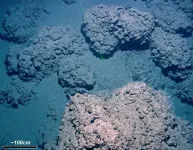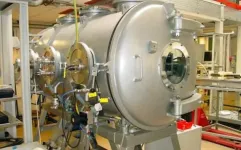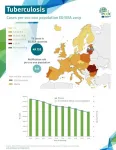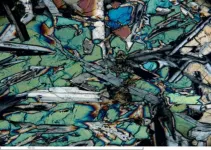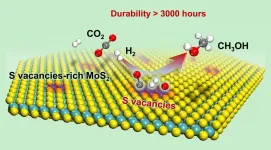(Press-News.org) Boulder, Colo., USA: Beneath the cold, dark depths of the Arctic ocean sit vast reserves of methane. These stores rest in a delicate balance, stable as a solid called methane hydrates, at very specific pressures and temperatures. If that balance gets tipped, the methane can get released into the water above and eventually make its way to the atmosphere. In its gaseous form, methane is one of the most potent greenhouse gases, warming the Earth about 30 times more efficiently than carbon dioxide. Understanding possible sources of atmospheric methane is critical for accurately predicting future climate change.
In the Arctic Ocean today, ice sheets exert pressure on the ground below them. That pressure diffuses all the way to the seafloor, controlling the precarious stability in seafloor sediments. But what happens when the ice sheets melt?
New research, published on today in Geology, indicates that during the last two global periods of sea-ice melt, the decrease in pressure triggered methane release from buried reserves. Their results demonstrate that as Arctic ice, such as the Greenland ice sheet, melts, similar methane release is likely and should be included in climate models.
Pierre-Antoine Dessandier, a postdoctoral scientist at the Arctic University of Norway, and his co-authors were interested in two periods around 20 thousand years ago (ka), known as the Last Glacial Maximum (LGM), and 130 ka, known as the Eemian deglaciation. Because the Eemian had less ice and was warmer than the LGM, it is more similar to what the Arctic is experiencing today, serving as a good analogue for future climate change.
"The oldest episode recorded (Eemian) is very important because it was a strong interglacial in the Arctic, with very similar climate characteristics to what is happening today," Dessandier said. "The idea with the Eemian interglacial is to... compare that with what could happen in the future. Seafloor methane emission is important to consider for modeling spatial estimations of future climate."
To track past methane release, Dessandier measured isotopes of carbon (carbon molecules with slightly different compositions) in the shells of tiny ocean-dwellers called foraminifera. Because the foraminifera build their shells using ingredients from the water around them, the carbon signal in the shells reflects the chemistry of the ocean while they were alive. After they die, those shells are preserved in seafloor sediments, slowly building a record spanning tens of thousands of years.
To reach that record, Dessandier and the team needed to drill a deep core off the western coast of Svalbard, a Norwegian archipelago in the Arctic Ocean. The team collected two cores: a 60-meter reference core, which they used to date and correlate stratigraphy, and a 22-meter core spanning the LGM and the Eemian deglaciations. The site for the 22-meter core was chosen based on its "pockmark" feature, marking where the gas escaped violently in the past, and massive carbonate rocks that form where methane is still leaking out today.
Carbon isotopes of microscopic shells in the long core revealed multiple episodes of methane release, which geochemists recognize from their distinct spikes in the record. Because methane is still seeping from the sediments, Dessandier needed to to make sure the signal wasn't from modern interference. He compared the shells' carbon isotope values to measurements his colleagues made on carbonate minerals that formed outside the shells, after the foraminifera had died, when methane emission was at its most intense.
The isotopic record showed that as ice melted and pressure on the seafloor lessened, methane was released in violent spurts, slow seeps, or--most likely--a combination of both. By the time the ice disappeared completely, some thousands of years later, methane emissions had stabilized.
How much methane eventually made it to the atmosphere, which is what would contribute to the greenhouse effect, remains uncertain. Part of the problem in quantifying this is the microbial communities that live on the seafloor and in the water, and that use methane to survive.
"For the microbes, it's an oasis. It's fantastic," Dessandier said. "So they grow like crazy, and some species produce methane and others consume it." That activity complicates the core's detailed carbon record. In sediments, a bustling community with lots of methane recycling could overprint the original signal; in the water column, where nutrients may be less plentiful, methane could get gobbled up or transformed into carbon dioxide before it reaches the atmosphere.
Despite modern complications, the team has pinpointed two methane releases associated with ice retreat, like they hypothesize could happen today. The best part for Dessandier was discovering layers of massive bivalves in the cores which, based on modern observations from remotely operated vehicles, can indicate a methane leak. "It was super interesting for us to observe these same sorts of layers at the LGM and the Eemian," he said. "It confirmed what we thought at the beginning, with a methane-rich seafloor allowing this community to develop... We can say that these events are very similar, with similar processes happening during both periods of warming. So this is something to consider for our current warming. It could happen again."
INFORMATION:
FEATURED ARTICLE
Ice-sheet melt drove methane emissions in the Arctic during the last two interglacials
Authors: P.-A. Dessandier; J. Knies; A. Plaza-Faverola; C. Labrousse; M. Renoult; G. Panieri
Contact: pa.dessandier@gmail.com
URL: https://pubs.geoscienceworld.org/gsa/geology/article/doi/10.1130/G48580.1/595627/Ice-sheet-melt-drove-methane-emissions-in-the
GEOLOGY articles are online at http://geology.geoscienceworld.org/content/early/recent. Representatives of the media may obtain complimentary articles by contacting Kea Giles at the e-mail address above. Please discuss articles of interest with the authors before publishing stories on their work, and please make reference to GEOLOGY in articles published. Non-media requests for articles may be directed to GSA Sales and Service, gsaservice@geosociety.org.
https://www.geosociety.org
Screenings for breast cancer and colon cancer dropped dramatically during the early months of the coronavirus pandemic, but use of the procedures returned to near-normal levels by the end of July 2020, according to a new study.
Analyzing insurance claims from more than 6 million Americans with private health coverage, researchers found that mammography rates among women aged 45 to 64 declined by 96% during March and April 2020 as compared to January and February.
Similarly, the weekly rate of colorectal cancer screenings among adults aged 45 to 64 and older declined by 95% during the period.
By the end of July 2020, however, the rate of mammograms among women had rebounded and was slightly higher than it had been before the pandemic was declared. The rate of colonoscopies also rebounded, ...
Researchers at Trinity College Dublin have been shedding light on the enigmatic "spiders from Mars", providing the first physical evidence that these unique features on the planet's surface can be formed by the sublimation of CO2 ice.
Spiders, more formally referred to as araneiforms, are strange-looking negative topography radial systems of dendritic troughs; patterns that resemble branches of a tree or fork lightning. These features, which are not found on Earth, are believed to be carved into the Martian surface by dry ice changing directly from solid to gas (sublimating) in the spring. Unlike Earth, Mars' atmosphere comprises mainly of CO2 and as temperatures decrease in winter, this deposits onto the surface as CO2 ...
Optical resonators provide the foundation of modern photonics and optics. Thanks to its extreme energy confinement, the high-Q-factor optical resonator optimizes light-matter interaction and photonic device performance by enabling low-threshold laser and enhanced nonlinear harmonic generation.
Two typical structures, the photonic crystal cavity and the whispering gallery cavity, are frequently used to obtain extremely high-Q factors. However, these structures may require dimensions that are comparable to--or several times larger than--the operating wavelength. Whether there is a general way to find out all high-Q modes in a dielectric ...
The tuberculosis (TB) burden in the WHO European Region as a whole is decreasing, and is down 19% overall for 2015-2019, according to the latest WHO/European Centre for Disease Prevention and Control (ECDC) report Tuberculosis surveillance and monitoring in Europe 2021 (2019 data).
Regional TB mortality has gone down, declining by 9.4% between 2018 and 2019. This is notably higher than the average global decline in TB mortality (3.7%) and enough to have reached the End TB Strategy milestone of a 35% reduction by 2020 compared to 2015.
However, TB is second only to COVID-19 as an infectious disease that kills, and drug resistance is a major concern. There are also worrying indications that the COVID-19 pandemic may stall progress or cause significant setbacks in the fight against TB.
The ...
Developing a standardized drying protocol for goldenseal could lead to more predictable health applications and outcomes by preserving the alkaloids found in the plant, which is native to Appalachia, according to Penn State researchers, who conducted a new study of the medicinal forest herb.
The roots and rhizomes of goldenseal -- Hydrastis canadensis -- have been used for hundreds of years as a source of antimicrobials and compounds to treat intestinal ailments, noted study co-author Eric Burkhart, associate teaching professor, ecosystem science ...
Antibody injections are a highly desirable treatment for people with chronic diseases such as cancer, psoriasis, Crohn's disease and arthritis. And recently, antibodies have been in the news as a promising treatment for severe cases of COVID-19.
But the costly, time-consuming manufacturing process to produce antibodies prevents these treatments from being accessible to most patients.
Andrew Zydney, Bayard D. Kunkle Chair and professor of chemical engineering at Penn State, has identified a new method to manufacture antibodies, which could drive down the production cost. His research results were recently published in Biotechnology Progress.
"If you look at the top 10 best-selling medications, by annual sales, eight ...
A new type of rock created during large and exceptionally hot volcanic eruptions has been discovered beneath the Pacific Ocean.
An international team of researchers including the University of Leeds unearthed the previously unknown form of basalt after drilling through the Pacific ocean floor.
The discovery suggests that ocean floor eruptions sourced in the Earth's mantle were even hotter and more voluminous than previously thought. Report co-author is Dr Ivan Savov, of Leeds' Institute of Geophysics and Tectonics, in the university's School of Earth and Environment.
He said: "In an era when we rightly admire discoveries made through space exploration, our findings show there are still many discoveries still to make on our ...
The increasing frequency and severity of extreme weather events like droughts and floods have taken a toll on the midwestern U.S. in recent years, putting a major strain on the region's farmers. From 2001 to 2010, the Federal Crop Insurance Program, a government program created to protect farmers from crop loss, covered $4.1 billion in damages; in 2011 alone, the program paid out $10.8 billion.
With the largest U.S. crop -- corn -- conservatively estimated to drop in yield anywhere from 20 to 80 percent due to extreme weather exacerbated by climate change, insurance claims may skyrocket to levels that may not be sustainable. But researchers from the Yale School of the Environment (YSE) found that by considering soil properties when determining insurance premiums ...
Less than a decade after unveiling the "Map of Life," a global database that marks the distribution of known species across the planet, Yale researchers have launched an even more ambitious and perhaps important project -- creating a map of where life has yet to be discovered.
For Walter Jetz, a professor of ecology and evolutionary biology at Yale who spearheaded the Map of Life project, the new effort is a moral imperative that can help support biodiversity discovery and preservation around the world.
"At the current pace of global environmental change, there is no doubt that many species will go extinct before we have ever learned ...
Efficient conversion of CO2 is strategically significant for alleviating the energy crisis and achieving the goal of carbon neutrality. One promising conversion route is the hydrogenation of CO2 to methanol using a renewable energy-based "green hydrogen" source.
Traditional metal oxide catalysts for this reaction typically require a high temperature (>300 oC), which tends to promote undesired reverse water-gas shift (RWGS) side reactions, thus producing a large amount of CO as the by-product.
Introduction of transition metal components onto metal oxides can promote the activation of H2, thereby reducing the reaction temperature, but this also facilitates excessive hydrogenation of CO2 to CH4, leading to lowered methanol selectivity. Further improvement of the performance ...
